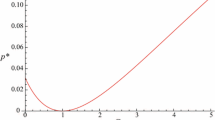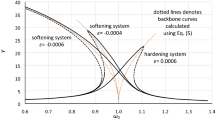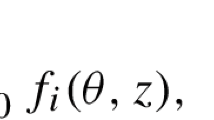Abstract
In this paper, we consider a linear oscillator subject to periodic excitation coupled to a nonlinear energy sink with piecewise-quadratic damping characteristics. The damping model includes a time delay to take into account the time needed to change the damping characteristics. In the framework of singular perturbation theory, an analytical/numerical procedure combining complexification, averaging, and multiple scale approaches is used to predict period and quasiperiodic response regimes. The analytical predictions agree satisfactorily with numerical results. It is shown that introducing a relatively small time delay causes significant modifications in the system regimes including suppression of quasiperiodic response regimes and reduction of the response level.










Similar content being viewed by others
References
Ahmadabadi, Z.N., Kadem, S.E.: Annihilation of high-amplitude periodic responses of a forced two degrees-of-freedom oscillatory system using nonlinear energy sink. J. Vib. Control 19(16), 2401–2412 (2012)
Bellet, R., Cochelin, B., Côte, R., Mattei, P.O.: Enhancing the dynamic range of targeted energy transfer in acoustics using several nonlinear membrane absorbers. J. Sound Vib. 331(26), 5657–5668 (2012)
Bellet, R., Cochelin, B., Herzog, P., Mattei, P.O.: Experimental study of targeted energy transfer from an acoustic system to a nonlinear membrane absorber. J. Sound Vib. 329, 2768–2791 (2010)
Bergeot, B., Bellizzi, S., Cochelin, B.: Analysis of steady-state response regimes of a helicopter ground resonance model including a non-linear energy sink attachment. Int. J. Non-Linear Mech. 78, 72–89 (2016)
Desroches, M., Guckenheimer, J., Krauskopf, B., Kuehn, C., Osinga, H.M., Wechselberger, M.: Mixed-mode oscillations with multiple time scales. SIAM Rev. 54(2), 211–288 (2012)
Febbo, M., Machado, S.: Nonlinear dynamic vibration absorbers with a saturation. J. Sound Vib. 332, 1465–1483 (2013)
Fenichel, N.: Geometric singular perturbation theory for ordinary differential equations. J. Differ. Equ. 98, 53–98 (1979)
Frahm, H.: A device for damped vibrations of bodies. U.S. Patent p. 989959 (1909)
Gourc, E., Seguy, S., Michon, G., Berlioz, A.: Chatter control in turning process with a nonlinear energy sink. Adv. Mater. Res. 698, 89–98 (2013)
Habib, G., Detroux, T., Viguie, R., Kerschen, G.: Nonlinear generalization of Den Hartog’s equal-peak method. Mech. Syst. Signal Process. 52–53, 17–28 (2015)
Habib, G., Kerschen, G., Stepan, G.: Chatter mitigation using the nonlinear tuned vibration absorber. Int. J. Non-Linear Mech. 91, 103–112 (2017)
Hale, J.K.: Averaging methods for differential equations with retarded arguments and a small parameter. J. Differ. Equ. 1, 57–73 (1966)
Harris, C., Piersol, A.: Shock and Vibration Handbook, 5th edn. McGraw-Hill Inc, New York (2002)
Hu, H.Y., Wang, Z.H.: Singular perturbation methods for nonlinear dynamic systems with time delays. Chaos Solitons Fractals 40, 13–27 (2009)
Korenev, B., Reznikov, L.: Dynamic Vibration Absorbers. Theory and Technical Applications. Wiley, Hoboken (1993)
Lehman, B., Weibel, S.P.: Fundamental theorems of averaging for functional differential equations. J. Differ. Equ. 152, 160–190 (1999)
Luongo, A., Zulli, D.: Aeroelastic instability analysis of nes-controlled systems via a mixed multiple scale/harmonic balance method. J. Vib. Control 20, 1985–1998 (2014)
Manevitch, L.: Complex representation of dynamics of coupled nonlinear oscillators. In: Uvarova, L., Arinstein, A., Latyshev, A. (eds.) Mathematical Models of Non-linear Excitations, Transfer, Dynamics, and Control in Condensed Systems and Other Media, pp. 269–300. Springer, New York (1999)
Masri, S., Ibrahim, A.: Stochastic excitation of a simple system with impact damper. Earthq. Eng. Struct. Dyn. 1, 337–346 (1973)
Nashif, A., Jones, D., Henderson, J.: Vibration Damping. Wiley, Hoboken (1985)
Ormondroyd, J., Den Hartog, J.: The theory of the dynamic vibration absorber. Trans. ASME 50, 9–22 (1928)
Pham, T., Lamarque, C., Savadkoohi, A.T.: Multi-resonance capturing in a two-degree-of-freedom system under two different harmonic excitations. J. Vib. Control 18(3), 451–466 (2012)
Roberson, R.: Synthesis of a nonlinear dynamic vibration absorber. J. Frankl. Inst. 254(3), 205–220 (1952)
Starosvetsky, Y., Gendelman, O.: Dynamics of a strongly nonlinear vibration absorber coupled to a harmonically excited two-degree-of-freedom system. J. Sound Vib. 312, 234–256 (2008)
Starosvetsky, Y., Gendelman, O.: Response regimes of linear oscillator coupled to nonlinear energy sink with harmonic forcing and frequency detuning. J. Sound Vib. 315, 746–765 (2008)
Starosvetsky, Y., Gendelman, O.: Strongly modulated response in forced 2DOF oscillatory system with essential mass and potential asymmetry. Physica D 237, 1719–1733 (2008)
Starosvetsky, Y., Gendelman, O.: Vibration absorption in systems with a nonlinear energy sink: nonlinear damping. J. Sound Vib. 324, 916–939 (2009)
Vakakis, A., Gendelman, O., Bergman, L., McFarland, D., Kerschen, G., Lee, Y.: Nonlinear Targeted Energy Transfer in Mechanical and Structural Systems, Solid Mechanics and Its Applications, vol. 156. Springer, Berlin (2008)
Vakakis, A., Manevitch, L., Gendelman, O., Bergman, L.: Dynamics of linear discrete systems connected to local, essentially non-linear attachments. J. Sound Vib. 264, 559–577 (2003)
Vakakis, A.F.: Shock isolation through the use of nonlinear energy sinks. J. Vib. Control 9(1–2), 79–93 (2003)
Vyas, A., Bajaj, K.: Dynamic of autoparametric vibration absorber using multiple pendulums. J. Sound Vib. 246(1), 115–135 (2001)
Acknowledgements
This work was supported by CAPES (Brazil) and COFECUB (France) agencies (under CAPES project No Ph 913/18 and COFECUB project No Ph 907/18).
Author information
Authors and Affiliations
Corresponding author
Ethics declarations
Conflict of interest
The authors declare that they have no conflict of interest concerning the publication of this manuscript.
Additional information
Publisher's Note
Springer Nature remains neutral with regard to jurisdictional claims in published maps and institutional affiliations.
Appendix: 1 D mapping procedure for relaxation oscillations (SMR)
Appendix: 1 D mapping procedure for relaxation oscillations (SMR)
This 1D mapping procedure was developed from [24, 26] to investigate the annihilation of the SMR (or relaxation oscillation).
This procedure is limited to CM shapes as given in Fig. 3. They correspond to the following assumptions: the CM admits two (at \(N_2^1\) and \(N_2^2\) or at \(N_2^1\) and 1) or four (at \(N_2^1\), 1, \(N_2^2\) and \(N_2^3\)) local extrema. The first local maximum is located at \(N_2^{1}\) and it is differentiable local maximum. We also assume that the excitation amplitude A satisfies condition (76) at \(N_2^{1}\) that is to say two singular equilibrium points exist on the fold line associated with \(N_2^{1}\). They are characterized by the angular coordinates \(\varDelta _2^{1-}\) and \(\varDelta _2^{1+}\) given by Eq. (75). In the sequel, we will assume that \(\varDelta _2^{1-} < \varDelta _2^{1+}\).
Existence of singular equilibrium points is a necessary condition but not sufficient to ensure the existence of a SMR also named relaxation oscillation. A relaxation oscillation regime corresponds to a motion that is a succession of relaxation cycles. A relaxation cycle alternates between epochs of fast-slow-fast-slow motions [as shown in Fig. 11 curves (1) to (4)]. The epochs of fast motions correspond to jumps from a point on a fold line to a point on the CM (see curves (1) and (3) Fig. 11). The epochs of slow motions correspond to a motion on the CM with an endpoint on a fold line (see curves (2) and (4) Fig. 11).
The objective of the procedure is to verify numerically that, \(\forall \;\varDelta _2^{\text{ init }} \in [\varDelta _2^{1-},\varDelta _2^{1+}]\), the end point \((N_2^{\text{ end }},\varDelta _2^{\text{ end }})\) of the cycle starting at \((N_2^{1},\varDelta _2^{\text{ init }})\) satisfies the two conditions: (i) \(N_2^{\text{ end }} = N_2^{1}\) and (ii) \(\varDelta _2^{\text{ end }}\in [\varDelta _2^{1-},\varDelta _2^{1+}]\).
A cycle corresponds to the following four steps:
-
Step 1:
(fast motion, curve (1) Fig. 11)
This step corresponds to a jump from \((N_2^{1},\varDelta _2^{\text{ init }})\) to a point \((N_2^{1(1)},\varDelta _2^{\text{ init }(1)})\) on the CM assuming Equation (47) preserved.
\((N_2^{1(1)},\varDelta _2^{\text{ init }(1)})\) is obtained solving
$$\begin{aligned} H(N_2^{1(1)}) = H(N_2^{1}) \end{aligned}$$(83)with respect to \(N_2^{1(1)}\) and using Equation (52) to deduce \(\varDelta _2^{\text{ init }(1)}\).
-
Step 2:
(slow motion, curve (2) Fig. 11)
This step corresponds to a slow motion in the CM from \((N_2^{1(1)},\varDelta _2^{\text{ init }(1)})\) to \((N_2^{1(2)},\varDelta _2^{\text{ init }(2)})\) where \(N_2^{1(2)}=N_2^{2}\) or \(N_2^{\text{ sw }}\) or \(N_2^{3}\) depending the assumption on the local minima.
\((N_2^{1(2)},\varDelta _2^{\text{ init }(2)})\) is obtained solving the differential equations (64, 65) with the initial condition \((N_2^{1(1)},\varDelta _2^{\text{ init }(1)})\) up to the time \(t^{(2)}\) where \(N_2(t^{(2)}) = N_2^{2}\) or \(N_2^{\text{ sw }}\) or \(N_2^{3}\) as \(N_2^{1(2)} = N_2(t^{(2)})\) and \(\varDelta _2^{\text{ init }(2)} = \varDelta _2(t^{(2)})\).
-
Step 3:
(fast motion, curve (3) Fig. 11)
This step corresponds to a jump from \((N_2^{1(2)},\varDelta _2^{\text{ init }(2)})\) to a point \((N_2^{1(3)},\varDelta _2^{\text{ init }(3)})\) on the CM assuming Equation (47) preserved.
\((N_2^{1(3)},\varDelta _2^{\text{ init }(3)})\) is obtained solving
$$\begin{aligned} H(N_2^{1(3)}) = H(N_2^{1(2)}) \end{aligned}$$(84)with respect to \(N_2^{1(3)}\) and using Equation (52) to deduce \(\varDelta _2^{\text{ init }(3)}\).
Note that due to the geometry of the CM (see Fig. 3), \(N_2^{1(3)}\) is always smaller than \(N_2^{1}\) and Step 4 is valid.
-
Step 4:
(slow motion, curve (4) Fig. 11)
This step corresponds to a slow motion in the CM from \((N_2^{1(3)},\varDelta _2^{\text{ init }(3)})\) to \((N_2^{\text{ end }},\varDelta _2^{\text{ end }})\) where \(N_2^{\text{ end }}=N_2^{1}\).
\((N_2^{\text{ end }},\varDelta _2^{\text{ end }})\) is obtained solving the differential equations (64, 65) with the initial condition \((N_2^{1(3)},\varDelta _2^{\text{ init }(3)})\) up to the time \(t^{\text{ end }}\) where \(N_2(t^{\text{ end }}) = N_2^{1}\) as \(N_2^{\text{ end }} = N_2(t^{\text{ end }})\) and \(\varDelta _2^{\text{ init }} = \varDelta _2(t^{\text{ end }})\).
In practice, cycles are computed using N points linearly spaced between \(\varDelta _2^{1-}\) and \(\varDelta _2^{1+}\) as starting points. If, for all the points, the cycles can be built and at the end of step 4 the points return inside the interval \([\varDelta _2^{1-},\varDelta _2^{1+}]\), the relaxation oscillation (SMR) is stable. On the other hand, the relaxation oscillation (SMR) do not appear.
Numerical results presented in this paper were obtained using \(N=100\).
Rights and permissions
About this article
Cite this article
Bellizzi, S., Chung, KW. & Sampaio, R. Response regimes of a linear oscillator with a nonlinear energy sink involving an active damper with delay. Nonlinear Dyn 97, 1667–1684 (2019). https://doi.org/10.1007/s11071-019-05089-0
Received:
Accepted:
Published:
Issue Date:
DOI: https://doi.org/10.1007/s11071-019-05089-0





